学术英语摘要写作
- 格式:doc
- 大小:34.00 KB
- 文档页数:1
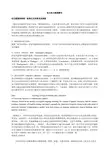
论文英文摘要撰写论文摘要的种类、结构与文体要求及要素一篇论文的摘要在本质上就是一篇浓缩的论文,它是作者对研究过程、研究目的、研究方法和研究结果的简要陈述和概括,其结构与论文的主体结构相对应。
论文的英文摘要存在的问题有涉及结构内容方面的,有涉及句法词法方面的,也有涉及时态语态方面的。
下面我们首先对论文英文摘要的种类、功能与结构和英文摘要撰写的一般原则和基本步骤做以介绍;接下来对论文英文摘要撰写中的常见问题做出归纳并进行实例分析和提出相应解决方法。
1、摘要的种类与结构摘要一般分为两类:信息性摘要和指示性摘要。
当今绝大部分的科技期刊和会议论文都要求作者提供信息性摘要。
1)信息性(报道性)摘要(Informative Abstract)信息性摘要即报道性摘要,也称资料性摘要,它是原文内容要点的具体总结,主要由四个部分组成:(1)研究的目的(Objective or Purpose);(2)研究的过程与采用的方法(Process and Method);(3)主要成果或发现(Results or Findings);(4)主要结论和推论(Conclusion)。
有的摘要的第一部分还包括背景介绍(Background)。
实际上,信息性摘要是论文的高度浓缩,相当于论文的简介或概要。
本科毕业论文的摘要按其种类来讲应当属于信息性摘要。
(信息性摘要范文请见第6-7页:第二部分;二;至1、摘要的要素)2)指示性摘要(Indicative Abstract,Descriptive Abstract)指示性摘要即介绍性摘要,也称陈述性摘要。
它主要介绍论文的论题,或者概括表述研究的目的,用简单几句话使读者对论文所研究的主要内容有一个概括的了解,不需要介绍方法、结果、结论等具体内容,也不需要用数据进行定量描述。
指示性摘要只讲述论文的主题思想,不涉及或很少涉及细节问题,但要指明文献的论题和所取得的成果的性质及所达到的水平。
下面就是一篇题目为《英语写作教学与大学生综合素质培养》论文的英文题目及其指示性摘要的范文。
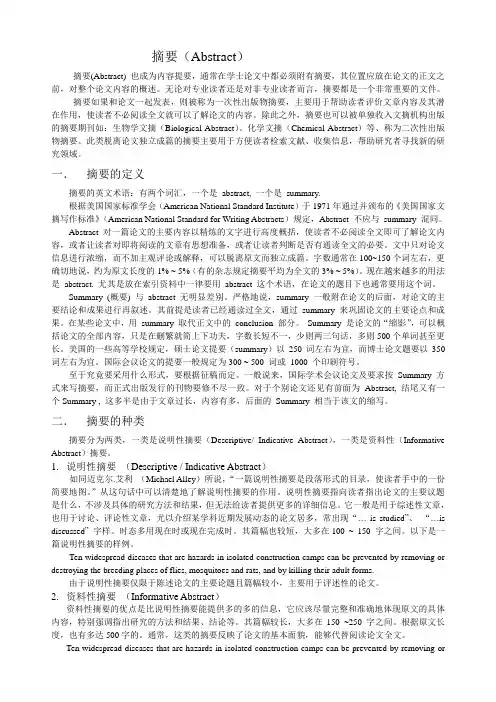
摘要(Abstract)摘要(Abstract) 也成为内容提要,通常在学士论文中都必须附有摘要,其位置应放在论文的正文之前,对整个论文内容的概述。
无论对专业读者还是对非专业读者而言,摘要都是一个非常重要的文件。
摘要如果和论文一起发表,则被称为一次性出版物摘要,主要用于帮助读者评价文章内容及其潜在作用,使读者不必阅读全文就可以了解论文的内容。
除此之外,摘要也可以被单独收入文摘机构出版的摘要期刊如:生物学文摘(Biological Abstract)、化学文摘(Chemical Abstract)等、称为二次性出版物摘要。
此类脱离论文独立成篇的摘要主要用于方便读者检索文献、收集信息,帮助研究者寻找新的研究领域。
一.摘要的定义摘要的英文术语:有两个词汇,一个是abstract, 一个是summary.根据美国国家标准学会(American National Standard Institute)于1971年通过并颁布的《美国国家文摘写作标准》(American National Standard for Writing Abstracts)规定,Abstract 不应与summary 混同。
Abstract 对一篇论文的主要内容以精炼的文字进行高度概括,使读者不必阅读全文即可了解论文内容,或者让读者对即将阅读的文章有思想准备,或者让读者判断是否有通读全文的必要。
文中只对论文信息进行浓缩,而不加主观评论或解释,可以脱离原文而独立成篇。
字数通常在100~150个词左右,更确切地说,约为原文长度的1% ~ 5%(有的杂志规定摘要平均为全文的3% ~ 5%)。
现在越来越多的用法是abstract. 尤其是放在索引资料中一律要用abstract 这个术语,在论文的题目下也通常要用这个词。
Summary (概要) 与abstract 无明显差别。
严格地说,summary 一般附在论文的后面,对论文的主要结论和成果进行再叙述。
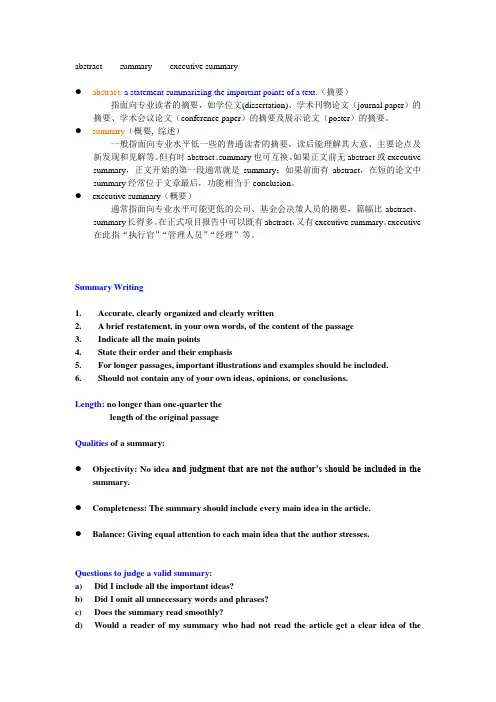
abstract summary executive summary●abstract: a statement summarizing the important points of a text.(摘要)指面向专业读者的摘要,如学位文(dissertation)、学术刊物论文(journal paper)的摘要、学术会议论文(conference paper)的摘要及展示论文(poster)的摘要。
●summary(概要, 综述)一般指面向专业水平低一些的普通读者的摘要,读后能理解其大意、主要论点及新发现和见解等。
但有时abstract、summary也可互换。
如果正文前无abstract或executive summary,正文开始的第一段通常就是summary;如果前面有abstract,在短的论文中summary经常位于文章最后,功能相当于conclusion。
●executive summary(概要)通常指面向专业水平可能更低的公司、基金会决策人员的摘要,篇幅比abstract、summary长得多。
在正式项目报告中可以既有abstract,又有executive summary。
executive 在此指“执行官”“管理人员”“经理”等。
Summary Writing1.Accurate, clearly organized and clearly written2. A brief restatement, in your own words, of the content of the passage3.Indicate all the main points4.State their order and their emphasis5.For longer passages, important illustrations and examples should be included.6.Should not contain any of your own ideas, opinions, or conclusions.Length: no longer than one-quarter thelength of the original passageQualities of a summary:●Objectivity: No idea and judgment that are not the author’s should be included in thesummary.●Completeness: The summary should include every main idea in the article.●Balance: Giving equal attention to each main idea that the author stresses.Questions to judge a valid summary:a)Did I include all the important ideas?b)Did I omit all unnecessary words and phrases?c)Does the summary read smoothly?d)Would a reader of my summary who had not read the article get a clear idea of thearticle?How to write a summary?Here is a five-step process for writing summaries:1)Read the article carefully, try to understand it accurately and look for main ideas.2)Write a list of points in note form while reading the passage or the article.3)Connect your points to write a rough draft of the summary in your own words.Refer to the passage or the article only when you want to make sure of some points.Do not count the number of words until you have finished your rough draft.4)Revise the rough draft, inserting transitional words and phrases where necessary toensure coherence.5)Write a fair copy of the summary within the word limit after checking forgrammatical corrections, punctuation and spelling.Suggestions on writing summaries:1)Omitting the details2)Reducing the examples3)Simplifying the descriptions4)Eliminating all repetitions5)Using phrases instead of sentences or clauses while writing a list of the points6)Using the shortest possible transitionsbut, then, yet, for, thus7)Avoiding figurative language8)Putting the main points of a dialogue in indirect speechSummarize the following article:As the plane circled over the airport, everyone sensed that something was wrong. The plane was moving unsteadily through the air, and although the passengers had fastened their seat belts, they were suddenly thrown forward. At that moment, the air-hostess appeared. She looked very pale, but was quite calm. Speaking quickly but almost in a whisper, she informed everyone that the pilot had fainted and asked if any of the passengers knew anything about the machines—o r at least how to drive a car. After a moment’s hesitation, a man got up and followed the hostess into the pilot’s cabin.Moving the pilot aside, the man took his seat and listened carefully to the urgent instructions that were being sent by radio from the airport below. The plane was now dangerously close to the ground, but to everyone’s relief, it soon began to climb. The man had to circle the airport several times in order to become familiar with the controls. But the danger had not yet passed. The terrible moment came when he had to land. Following instructions the man guided the plane towards the airfield. It shook violently as it touched the ground and then moved rapidly across the field, but after a long run it stopped safely. Outside, a crowd ofpeo ple who had been watching anxiously, rushed forward to congratulate the “pilot” on a perfect landing. (230 words)Making a list of main points:1.pilot fainted2.Air-hostess found a person3.Moved the pilot aside and listened to instructions.4.Plane flew low, climbed and circled the airport5.The man guided the plane--airport6.Touching ground, moved rapidly, stopped safely7.People rushed to congratulateWriting a rough draft:As there was something wrong with the plane, the passengers were thrown forward. At that moment, the air-hostess appeared and she looked for someone who could drive a car. Then, a passenger was led into the pilot’s cabin. When he moved the pilot aside, he sat down and listened to the urgent instructions which were being sent by radio from the airport below. Though the plane flew dangerously low, it soon climbed, and rounded the airport several times. Then, acting on instructions, the man guided the plane towards the airfield. On touching the ground, the plane moved rapidly until it stopped safely. After this, anxious people rushed forward to congratulate the “pilot” on a perfect landing. (116words)Making a fair copy:As the pilot fainted, the air-hostess managed to find a passenger to fly the plane. He followed instructions sent by radio from the airport below. The plane was flying dangerously low, but soon it began to climb and circle the airport. Acting on instructions, the man guided the plane toward the airfield. After touching the ground, the plane moved rapidly and stopped safely. People rushed to congratulate the “pilot” on the landing. (72 words)。
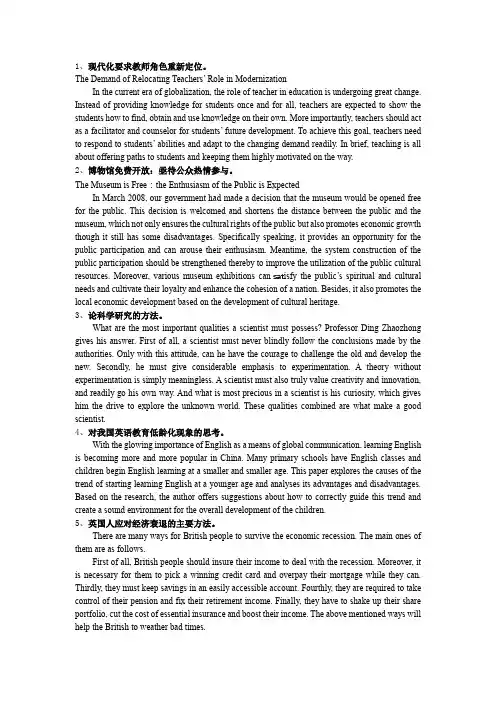
1、现代化要求教师角色重新定位。
The Demand of Relocating Teachers’ Role in ModernizationIn the current era of globalization, the role of teacher in education is undergoing great change. Instead of providing knowledge for students once and for all, teachers are expected to show the students how to find, obtain and use knowledge on their own. More importantly, teachers should act as a facilitator and counselor for students’ future development. To achieve this goal, teachers need to respond to students’ abilities and adapt to the changing demand readily. In brief, teaching is all about offering paths to students and keeping them highly motivated on the way.2、博物馆免费开放:亟待公众热情参与。
The Museum is Free:the Enthusiasm of the Public is ExpectedIn March 2008, our government had made a decision that the museum would be opened free for the public. This decision is welcomed and shortens the distance between the public and the museum, which not only ensures the cultural rights of the public but also promotes economic growth though it still has some disadvantages. Specifically speaking, it provides an opportunity for the public participation and can arouse their enthusiasm. Meantime, the system construction of the public participation should be strengthened thereby to improve the utilization of the publiccultural resources. Moreover, various museum exhibitions can sat isfy the pu blic’s spiritual andcultural needs and cultivate their loyalty and enhance the cohesion of a nation. Besides, it also promotes the local economic development based on the development of cultural heritage.3、论科学研究的方法。
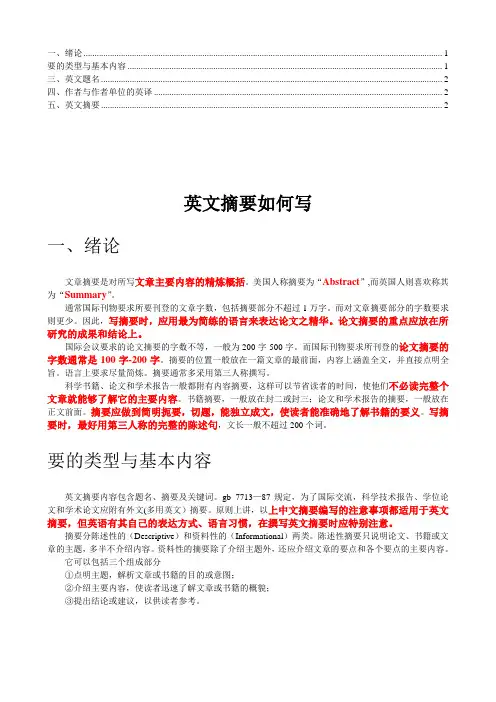
一、绪论 (1)要的类型与基本内容 (1)三、英文题名 (2)四、作者与作者单位的英译 (2)五、英文摘要 (2)英文摘要如何写一、绪论文章摘要是对所写文章主要内容的精炼概括。
美国人称摘要为“Abstract”,而英国人则喜欢称其为“Summary”。
通常国际刊物要求所要刊登的文章字数,包括摘要部分不超过1万字。
而对文章摘要部分的字数要求则更少。
因此,写摘要时,应用最为简练的语言来表达论文之精华。
论文摘要的重点应放在所研究的成果和结论上。
国际会议要求的论文摘要的字数不等,一般为200字-500字。
而国际刊物要求所刊登的论文摘要的字数通常是100字-200字。
摘要的位置一般放在一篇文章的最前面,内容上涵盖全文,并直接点明全旨。
语言上要求尽量简炼。
摘要通常多采用第三人称撰写。
科学书籍、论文和学术报告一般都附有内容摘要,这样可以节省读者的时间,使他们不必读完整个文章就能够了解它的主要内容。
书籍摘要,一般放在封二或封三;论文和学术报告的摘要,一般放在正文前面。
摘要应做到简明扼要,切题,能独立成文,使读者能准确地了解书籍的要义。
写摘要时,最好用第三人称的完整的陈述句,文长一般不超过200个词。
要的类型与基本内容英文摘要内容包含题名、摘要及关键词。
gb 7713—87规定,为了国际交流,科学技术报告、学位论文和学术论文应附有外文(多用英文)摘要。
原则上讲,以上中文摘要编写的注意事项都适用于英文摘要,但英语有其自己的表达方式、语言习惯,在撰写英文摘要时应特别注意。
摘要分陈述性的(Descriptive)和资料性的(Informational)两类。
陈述性摘要只说明论文、书籍或文章的主题,多半不介绍内容。
资料性的摘要除了介绍主题外,还应介绍文章的要点和各个要点的主要内容。
它可以包括三个组成部分①点明主题,解析文章或书籍的目的或意图;②介绍主要内容,使读者迅速了解文章或书籍的概貌;③提出结论或建议,以供读者参考。
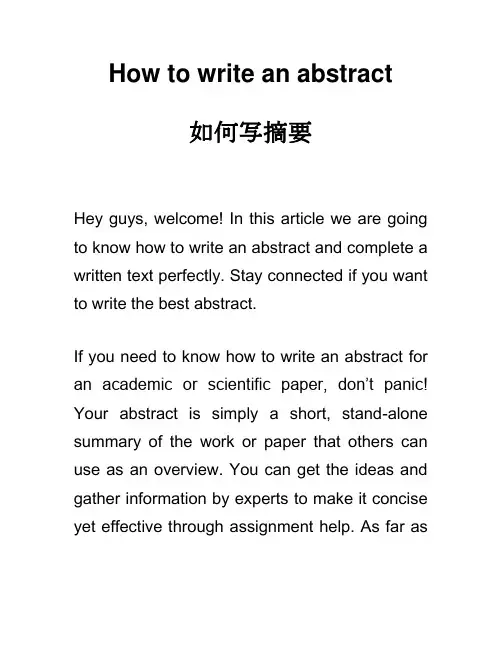
How to write an abstract如何写摘要Hey guys, welcome! In this article we are going to know how to write an abstract and complete a written text perfectly. Stay connected if you want to write the best abstract.If you need to know how to write an abstract for an academic or scientific paper, don’t panic! Your abstract is simply a short, stand-alone summary of the work or paper that others can use as an overview. You can get the ideas and gather information by experts to make it concise yet effective through assignment help. As far asthe other specifics are concerned, we will discuss them here.Before moving further let’s have an overview of this article to see what you are going to know:-What is an abstract?-How to write an abstract?-Why is it important to write an abstract?-How to write an abstract quickly?-The way to write an abstract for science?What is an abstract?Before moving to how to write an abstract, you should know the abstract meaning. An abstract describes what you do in your essay, whether it’s a scientific experiment or a literary analysis paper. It should help your reader understand the paper and help people searching for this paper decide whether it suits their purposes prior to reading.To write an abstract, finish your paper first, then type a summary that identifies the purpose, problem, methods, results, and conclusion of your work. After you get the details down, all that’s left is to format it correctly. Since an abstract is only a summary of the work you’ve already done, it’s e asy to accomplish!Majorly, there are three types of abstract:-Informative-Descriptive-CriticalHow to write an abstract?1. Write down the paper firstlyThe first thing to know how to write an abstract is : Even though an abstract goes at the beginning of the work, it acts as a summary of your entire paper. Rather than introducing your topic, it will be an overview of everything youwrite about in your paper. Save writing your abstract for last, after you have already finished your paper.-A thesis and an abstract are entirely different things. The thesis of a paper introduces the main idea or question, while the abstract works to review the entirety of the paper, including the methods and results.-Even if you think that you know what your paper is going to be about, always save the abstract for last. You will be able to give a much more accurate summary if you do just that –summarise what you’ve already written. Let’s move to the next step to know how to write an abstract.2. Review and understand any requirements for writing your abstractThe paper you’re writing probably has specific guidelines and requirements, whether it’s for publication in a journal, submission in a class, or part of a work project. Before you start writing, refer to the rubric or guidelines you were presented with to identify important issues to keep in mind. Answer the following questions before knowing how to write an abstract.-Is there a maximum or minimum length?-Are there style requirements?-re you writing for an instructor or a publication?3. Consider your targeted audienceAbstracts are written to help readers find your work. For example, in scientific journals, abstracts allow readers to quickly decide whether the research discussed is relevant to their own interests. Abstracts also help your readers get at your main argument quickly. Keep the needs of your readers in mind this is the best thing to know for how to write an abstract.-Will other academics in your field read this abstract?-Should it be accessible to a lay reader or somebody from another field?4. Determine the type of abstractBefore moving to the question how to write an abstract, focus on which type of abstract do you want to write. Although all abstracts accomplish essentially the same goal, there are two primary styles of abstract: descriptive and informative. You may have been assigned a specific style, but if you weren’t, you will have to determine which is right for you. Typically, informative abstracts are used for much longer and technical research while descriptive abstracts are best for shorter papers.Have a look at the types of abstracts againDescriptive abstracts explain the purpose, goal, and methods of your research but leave out theresults section. These are typically only 100-200 words.Informative abstracts are like a condensed version of your paper, giving an overview of everything in your research including the results. These are much longer than descriptive abstracts, and can be anywhere from a single paragraph to a whole page long.The basic information included in both styles of abstract is the same, with the main difference being that the results are only included in an informative abstract, and an informative abstract is much longer than a descriptive one.A critical abstract is not often used, but it may be required in some courses. A critical abstract accomplishes the same goals as the other typesof abstract, but will also relate the study or work being discussed to the writer’s own research. It may critique the research design or methods.5. Identify your motive of writing an abstractYou’re writing about a correlation between lack of lunches in schools and poor grades. So what? Why does this matter? The reader wants to know why your research is important, and what the purpose of it is. Start off your descriptive abstract by considering the following questions:How did you conduct your research?What did you find?Why is this research and your findings important?Why should someone read your entire essay? How to write an abstract6. Describe the problemAbstracts is something that expresses the “problem” behind your work. Think of this as the particular issue that your project addresses. You can sometimes combine the problem with your motivation, but it is best to be clear and separate the two.7. Describe your methodsMotivation – check. Problem – check. Methods? Now is the part where you give an overview of how you accomplished your study. If you didyour own work, include a description of it here. If you reviewed the work of others, it can be briefly explained.-Discuss your own research including the variables and your approach-Describe the evidence you have to support your claim-Give an overview of your most important sources.8. Describe your resultsThis is where you begin to make difference between your abstract between a descriptive and an informative abstract. You want to know how to write an abstract and this is somethingwhich should be in your priority list. In an informative abstract, you will be asked to provide the results of your study. What is it that you found?-What answer did you reach from your research or study?-Was your hypothesis or argument supported?-What are the general findings?9. Give the conclusion of abstractYou must finish up your summary and provide a closure to your abstract. In it, address the meaning of your findings as well as the importance of your overall paper. This format of having a conclusion can be used in bothdescriptive and informative abstracts, but you will only address some questions in an informative abstract.10. Keep the format rightIn the run to know how to write an abstract, format is a vital factor to consider. There are specific questions your abstract must provide answers for, but the answers must be kept in order as well. Ideally, it should be according to the overall format of your essay, with a general ‘introduction, ‘body,’ and ‘conclusion.’ Many journals have specific style guides for abstracts. If you’ve been given a set of rules or guidelines, follow them to the letter11. Provide helpful informationUnlike a topic paragraph, which may be intentionally vague, an abstract should provide a helpful explanation of your paper and your research. Word your abstract so that the reader knows exactly what you’re t alking about, and isn’t left hanging with ambiguous references or phrases.-Avoid using direct acronyms or abbreviations in the abstract, as these will need to be explained in order to make sense to the reader. That uses up precious writing room, and should generally be avoided.-If your topic is about something well-known enough, you can reference the names of people or places that your paper focuses on.-Don’t include tables, figures, sources, or long quotations in your abstract. These take up too much ro om and usually aren’t what your readers want from an abstract anyway. For making your abstract even better you gather relevant ideas, for doing so you can go to the expert writes through assignment help online12. Write it down from scratchA abstract is a summary of the main paper, yes, but it should be written completely separate from your paper. Don’t copy and paste direct quotes from yourself, and avoid simply paraphrasing your own sentences from elsewhere in your writing. Write your abstract using completely new vocabulary and phrases to keep itinteresting and redundancy-free. So, far we have gone through detailed information and steps to know how to write an abstract. But, what if someone is in a hurry and yet has to come up with a perfect abstract? Well, I have tips such people as well, continue to read and know how to write an abstract in lesser time.How to write an abstract quickly?Simply ace your abstract.An abstract is like a movie trailer. It offers a preview, highlights key points, and helps the audience decide whether to view the entire work. Abstracts are the pivot of a research paperbecause many journal editorial boards screen manuscripts only on the basis of the abstract.If your abstract doesn’t grab their attention and make a good fi rst impression, there’s a good chance your research paper will be rejected at the outset. Moreover, even after your research paper is published, your abstract will be the first, and possibly only, thing readers will access through electronic searches. They will only consider reading the rest of the manuscript if they find your abstract interesting.For studies in the humanities and social sciences, the abstract is typically descriptive. That is, it describes the topic of research and its findings but usuall y doesn’t give specific information about methods and results. These abstracts may also be seen in review articles orconference proceedings. In scientific writing, on the other hand, abstracts are usually structured to describe the background, methods, results, and conclusions, with or without subheadings.Make sure that your abstract does not constitutes the following-New information that is not present in the paper -Undefined abbreviations or group names-A discussion of previous literature or reference citations-Unnecessary details about the methods usedFollow these 10 steps to know how to write an abstract quicklyNow how do you go about fitting the essential points from your entire paper—why the research was conducted, what the aims were, how these were met, and what the main findings were—into a paragraph of just 200-300 words? It’s not an easy task, but here’s a 10-step guide that should make it easier:1. Begin writing the abstract after you have finished writing your paper.2. Pick out the major objectives/hypotheses and conclusions from your Introduction and Conclusion sections3. Select key sentences and phrases from your Methods section.4. Identify the major results from yourResults section.5. Now, arrange the sentences and phrases selected in all steps into a single paragraph in the following sequence: Introduction, Methods, Results, and Conclusions.6. Confirm that there is consistency between the information presented in the abstract and in the paper.7. Ask a colleague to review your abstract and check if the purpose, aim, methods, and conclusions of the study are clearly stated.8. Check to see if the final abstract meets the guidelines of the target journal (word limit, type of abstract, recommended subheadings, etc.9. Remove all extra information and then link your sentences to ensure that the information flows well, preferably in the following order: purpose; basic study design, methodology and techniques used; major findings; summary of your interpretations, conclusions, and implications.10. Now revisit your abstract with these steps in mind, and I’m sure you’ll be able to revise it and make it more attractive.How to write an abstract for science?So, here is something for science buffs. We know that science students are less into writing and formatting. But, they are one of the students who are indulged in research papers to the most. So, here is a collection of vital information for all the students who are going to write down a scientific research paper. Want to know how to write an abstract for science? Continue to read..An abstract should be the shortest part of the abstract and should very briefly outline the following information:What is already known about the subject, related to the paper in questionWhat is not known about the subject and hence what the study intended to examine (or what the paper seeks to present)Things you should rememberIn most cases, the background can be framed in just 2–3 sentences, with each sentence describing a different aspect of the information referred to above; sometimes, even a single sentence may suffice. The purpose of the background, as the word itself indicates, is to provide the reader with a background to the study, and hence to smoothly lead into a description of the methods employed in the investigation.Usually authors publish papers the abstracts of which contain a lengthy background section.There are some situations, perhaps, where this may be justified. In most cases, however, a longer background section means that less space remains for the presentation of the results. This is unfortunate because the reader is interested in the paper because of its findings, and not because of its background.Why an abstract is needed?Most journals require authors to submit abstracts along with their articles, This requirement has two main needs-An abstract offers readers a helpful, succinct summary of the longer argument developed in the essay.-It identifies keywords that will make it easier for search engines to find the essay.Apart from these two main reasons it serves two other needs as well. They are:Showcases the perspectiveNotice that these rationales presuppose the publication of both abstract and essay and, in so doing, assume that the main audience for the abstract is prospective readers of the publishedessay. However, from the perspective of an author submitting work to a journal, there is another important audience to consider: the journal editor and the external reviewers to whom the editor send it.Keep the audience connectedThis audience looks at your abstract with their most pressing question in mind: is this article publishable in this journal? A good abstract tilts them toward an affirmative answer by leaving them well-disposed toward the longer argument in th e article. A bad abstract won’t by itself cause this audience to reject an article, but it does incline the audience toward an initial negative answer. In that way, an ineffectiveabstract becomes an obstacle that your article needs to overcome.ConclusionHope, you guys have understood each and every aspect of writing an abstract. In this article, we went into the detailed discussion to know how to write an abstract. We started with abstract meaning and then moved to the steps which essayed the right way to write down one. Next, we studied points on how to write an abstract quickly. So, that those who are in a hurry to prepare a written text can write aptly. Thereafter, we went to know how to write an abstract for science and ended up in knowing why an abstract is vital.。
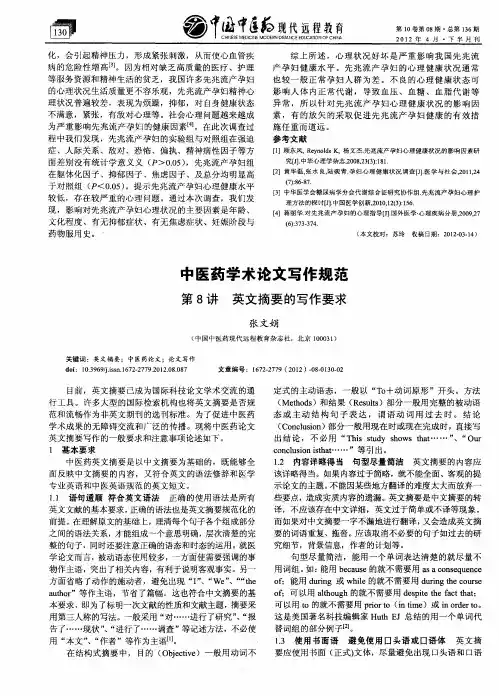

如何撰写毕业论文的英文摘要和关键词Writing the Abstract and Keywords for Your Graduation Thesis in EnglishAbstract:The abstract of a graduation thesis is a concise summary of the study and its findings. Written in English, it plays a crucial role in helping readers understand the main points of your research. In this article, we will discuss how to write an effective abstract for your graduation thesis and provide tips for selecting appropriate keywords.I. Components of an AbstractAn abstract typically consists of the following components:1. Background: Provide a brief introduction to the research topic, highlighting its significance and relevance. Explain why the topic is worth investigating.2. Objectives: Clearly state the research objectives and the main research question you aimed to answer.3. Methods: Briefly describe the research methods used in your study. Include information about the data collection process, sample size, and any statistical techniques employed.4. Results: Present the key findings of your research. The abstract should highlight the most important outcomes and discoveries.5. Conclusion: Summarize the implications of your findings and their potential impact on the field of study. Avoid incorporating new information or vague statements.II. Writing Style and LengthWhen writing the abstract, it is essential to maintain a concise and clear writing style. Keep in mind the following guidelines:1. Use clear and simple language: Avoid jargon or technical terms that may confuse non-expert readers. Explain any specialized terminology used in your study.2. Be concise: The abstract should generally be between 150-250 words. Use short, informative sentences to convey your main points.3. Use the active voice: Writing in the active voice enhances clarity and readability. Focus on the actions performed and highlight the significance of your research.4. Do not reference figures or tables: The abstract should be self-contained and not refer to any external resources or visuals.III. Selecting KeywordsKeywords are essential in academic publishing, helping indexers and researchers locate your work. Here are some tips on selecting effective keywords:1. Be specific: Choose words that accurately represent the main aspects of your study. Avoid generic or overly broad terms.2. Use synonyms and related terms: Including synonyms or related terms expands the discoverability of your work. It increases the likelihood that your article will appear in a wider range of searches.3. Consider the research field: Identify keywords commonly used in your field of study. This helps ensure your work aligns with similar publications and reaches the intended audience.4. Balance simplicity and complexity: Keywords should strike a balance between being understandable to non-experts and reflecting the disciplinary depth of your research.In conclusion, an effective abstract is a condensed representation of your graduation thesis. It should provide readers with a clear overview of your research topic, objectives, methods, results, and conclusions. Additionally, carefully selecting appropriate keywords enhances the visibility and accessibility of your work within academic databases. By following these guidelines, you can craft a compelling abstract that effectively communicates the essence of your research.。

论文英文摘要格式The abstract is a concise and informative summary of the main aspects of a research paper. It typically includes the purpose, methods, results, and conclusions of the study. The following is a recommended format for writing an abstract in English for a research paper:1. Introduction: Start the abstract by introducing the background and significance of the research topic.2. Objectives: Clearly state the research objectives or main research question that the study aims to address.3. Methods: Provide a brief description of the research design, methods, and materials used in the study.4. Results: Summarize the key findings or outcomes of the research. Include any statistical significance, if applicable.5. Conclusions: State the main conclusions or implications of the study and highlight their significance. Avoid generalizations and unsupported claims.6. Keywords: Include a list of relevant keywords or phrases that can help identify the main subject of the research.7. Length: Keep the abstract concise, usually between 150 to 250 words. Avoid including unnecessary details or referring to figures or tables.8. Language: Use clear and concise language. Avoid jargon and technical terms unless necessary. Use active voice and be specific in your descriptions.Remember that the abstract is often the first part of your research paper that readers will see, so it should be well-written and accurately represent the content of your study.。
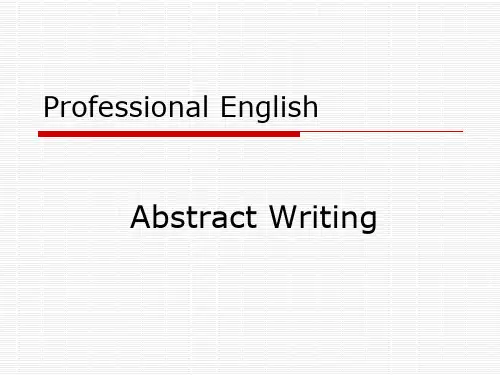
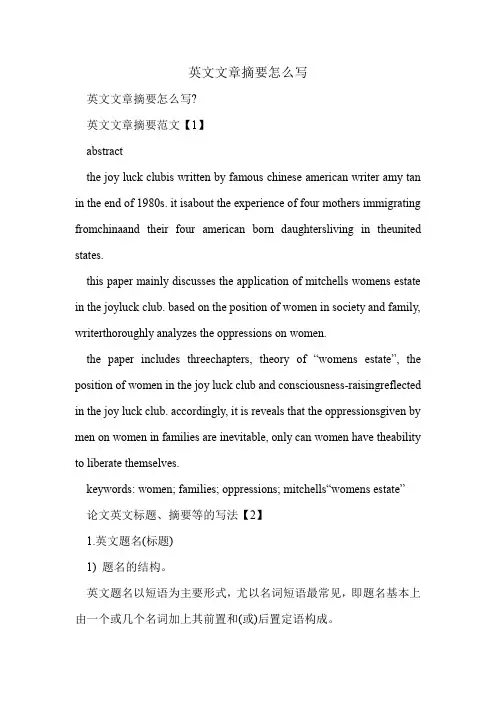
英文文章摘要怎么写英文文章摘要怎么写?英文文章摘要范文【1】abstractthe joy luck clubis written by famous chinese american writer amy tan in the end of 1980s. it isabout the experience of four mothers immigrating fromchinaand their four american born daughtersliving in theunited states.this paper mainly discusses the application of mitchells womens estate in the joyluck club. based on the position of women in society and family, writerthoroughly analyzes the oppressions on women.the paper includes threechapters, t heory of “womens estate”, the position of women in the joy luck club and consciousness-raisingreflected in the joy luck club. accordingly, it is reveals that the oppressionsgiven by men on women in families are inevitable, only can women have theability to liberate themselves.keywords: women; families; oppressions; mitchells“womens estate”论文英文标题、摘要等的写法【2】1.英文题名(标题)1) 题名的结构。
毕业论文英文摘要毕业论文英文摘要毕业论文英文摘要怎么写?有什么技巧吗?看看下面吧毕业论文英文摘要[1]ABSTRACTWeibo is one of the most important social media tools nowadays, thepopularization of Weibo brings a new kind of network marketing - Weibomarketing. Enterprises use Weibo' platform can carry out a series ofmarketing activities, in order to raise visibility and expand brand impact.Weibo marketing has gradually become one of the indispensablemarketing channels of many companies.However, as a new kind ofnetwork marketing, Weibo marketing has some significant differencefrom traditional marketing.In addition, the influence factors of Weibomarketing effectiveness has not been precisely defined, and marketingeffectiveness is difficult to scientific assessment.Therefore, the majorityof firms develop the Weibo marketing are blind, and Weibo marketing isstill at the exploratory stage.How much benefit Weibo marketing canbring for enterprises, which is the enterprise most concern.However, thescientific studies about the influence factors and evaluation of Weibomarketing effect are in a state of scarcity.This paper takes the hotel's Weibo as the research object, and deeplystudies the influence factors and evaluation of the Weibo marketingeffect:On the basis of summarizing those existing research on Weibomarketing, it is assumed that the decision-makers fromdifferent hotelshold tiie same degree of attention on Weibo marketing.Then, this paperexplores the influence factors of hotels' Weibo marketing effect from theWeibo users' perspective, analyzes the Weibo users' behavior guided byAISAS mode , tiirough the questionnaire survey to build the hotel Weibomarketing effect model with statistical software such as Excel and SPSS19.0.On this basis, this paper puts forward tiie Weibo marketing effectevaluation index hypothetical model, and then use AHP to build acomplete evaluation system , this system takes the hotels' Weibomarketing comprehensive effect as the goal layer, influence effect,communication effect and transformation effect as the criterion layer,takes Weibo influence, brand influence , interaction effect, fans value,actual trading volume and customer satisfaction as the sub-criterion layer,and takes 14 indexes such as Weibo influence index, brand hot degreesand brand search as the index layer.Finally, this evaluation index system is applied to Ningbo HowardJohnson Plaza Hotel and Ningbo Riviera Hotel.Through the observationand data collection of the hotels' Weibo, measure the hotel Weibomarketing effect index with the comprehensive index method.The resultsshow that these two hotels have little effect about Weibo marketing:1.Both hotels did not make full use of Weibo to launch various marketingactivities, Weibo marketing is still at a low level, and Weibo marketingdid not make the hotel brand awareness has obvious improvement;2.Those hotels are not ideal about the number oftransmission, commentand praise by Weibo users.Among their fans, the ratio of certified fans islow, while the ratio of active fans proportion is relatively substantial, andfew interactive activities are organized.So, how to attract a large numberof fans, and enhance the fans value is an urgent problem;3.The actualtrading volume is not optimistic.Although there is a higher satisfaction,customers release very few consumption experiences by Weibo during theinvestigation period.To some extent, both hotels reflect the problemsexisting in the hotel industry to carry out the Weibo marketing, thus, fortheir marketing situation, this article also brings up some suggestions andcountermeasures: 1.Accurate positioning, step by step;2.Grasp thefrequency and the best time on releasing information; 3.Showpersonalized content;4.Online and offline marketing activities arecombined together;5.Increase effective fans, pay attention to interactwith fans.KEYWORDS: Weibo marketing; Influencing factors; Effect evaluation;Indicator system毕业论文英文摘要[2]AbstractAs the information technology develops and the social network platform prospers,moreand more information are spreading and shared through the Internet.According to the uniqueadvantage that social network platform owns, many marketers also see the businessandpotential market there.They are also considering spreading the marketing information throughthis platform in a more efficient way.The research aims at find out those factors that influence people's online sharing behaviorabout marketing Information on social network sites.In the literature review, there are studiesanalyzing people's online shopping behavior, or online knowledge sharing behavior.But thereare few analyzing online marketing information sharing behavior.This study uses theoriesfrom sociology, ethology, economics and psychology to study the influential factors of onlinesharing behavior.It's based on the three main variances: Expected Reward from sociology andethology, Cost from economics, and Trust from the psychology but always mentioned underthe internet condition.These three variances were divided into more dimensions and differentcharacters of the marketing information were matched to them.We used factor analysis andregression analysis to find out which factors have more influence.The data was collectedthrough Sina Weibo platform and sample was based on marketing information of rewardingrepost.It turns out that Trust has the most obvious influence on the online sharing behavior,including dimensions of trust in information source, trust in information content andinstitutional mechanisms (Seal Programs)。
英文摘要万能模板篇一:英语摘要十大万能模板由于英语摘要是新题型,相对来讲比较难,但是大家摸清基本的套路和方法,就不会无从下笔了,下面的十个模板是从《MBA联考英语写作分册》摘录的,模板很简单,大家把模板背熟,到考试是直接套用就行了,不过最好先找几篇文章练练笔,熟悉一下流程。
英文摘要的基本方法就是:首先,写出中文摘要;其次,把它用简单的英文翻译过来并加以修改。
英文摘要的写作注意事项:1、英文摘要结构严谨,表达简明,语义确切。
尽量使用短句,慎用长句。
2、应采用第三人称表达方式,谓语动词用一般现在时、现在完成时或一般过去时。
进行时态和其他复合时态基本不用。
3、英文摘要的语态既可采用主动,也可采用被动。
英语摘要十大万能模板框架一In the first paragraph of the dissertation, the author highlights that due attention has to be paid to__. Several fundamental factors have contributed to such a tendency. First and foremost, among the most convincing causes identified by people, one should be stressed, that is __. In addition, as far as the author is concerned, __ is of utmost significance to our society. The last but not the least, as isillustrated in the last paragraph of the essay, the writer also takes __into consideration. Given all the above argument, we can draw the conclusion that __ is indeed crucial.在本段的第一段,强调我们必须充分重视_(中心词)。
英文学术论文写作学术论文写作用英语写学术论文的目的主要有两个,一是参加国际学术会议,在会议上宣讲,促进学术交流;二是在国际学术刊物上发表,使国外同行了解自己的研究成果,同样也是出于学术交流的目的。
不同的学科或领域、不同的刊物对论文的格式有不同的要求,但各个领域的研究论文在文体和语言特点上都有许多共性。
了解了这些语言共性,便会起到触类旁通的作用。
对我国青年学者或学生来说,用英语写作的难点不是没有写作材料,不是不熟悉专业词汇,也不是没有打下良好的英语基础。
用英语写论文难,是因为不太了解学术英语的语言特点。
关于学术英语写作的语言技巧,我们已在第一部分作了较详细的介绍。
此部分讨论学术论文写作的方法,包括学术论文写作中常用的句型结构,我们都在此作较详细介绍,以便读者模仿练习,将写作工作化难为易。
一般来说,一篇完整规范的学术论文由以下各部分构成:Title(标题)Abstract(摘要)Keywords(关键词)Table of contents(目录)Nomenclature(术语表)Introduction(引言)Method(方法)Results(结果)Discussion(讨论)Conclusion(结论)Acknowledgement(致谢)Reference(参考文献)Appendix(附录)其中Title,Abstract,Introduction,Method,Result,Discussion,Conclusion,Reference等八项内容是必不可少的(其他内容根据具体需要而定)。
在这八项内容中,读者最多的是Title,Abstract和Introduction部分,读者会根据这些内容来决定是否阅读全文。
也就是说,一篇研究论文赢得读者的多少,在很大程度上取决于Title,Abstract和Introduction写得好坏。
因此这三项内容将各分章详细加以讲述。
学术论文的正文一般包括Method,Result,Discussion三个部分。
ABSTRACT1:Parent-mediated social communication therapy for young children with autism (PACT): long-term follow-up of a randomised controlled trial.01、针对自闭症幼儿的父母介导的社区沟通疗法(PACT):随机对照试验的长期随访杂志( THE LANCET )发表年份(2016)期刊影响因子(53.254)Background: It is not known whether early intervention can improve long-term autism symptom outcomes. We aimed to follow-up the Preschool Autism Communication Trial (PACT), to investigate whether the PACT intervention had a long-term effect on autism symptoms and continued effects on parent and child social interaction.Methods: PACT was a randomised controlled trial of a parent-mediated social communication intervention for children aged 2–4 years with core autism. Follow-up ascertainment was done at three specialised clinical services centres in the UK (London, Manchester, and Newcastle) at a median of 5.75 years (IQR 5.42 –5.92) from the original trial endpoint. The main blinded outcomes were the comparative severity score (CSS) from the Autism Diagnostic Observation Schedule (ADOS) 自闭症诊断观察量表 , the Dyadic Communication Assessment Measure (DCMA) of the proportion of child initiatiations when interacting with the parent, and an expressive-receptive language composite. All analyses followed the intention-to-treat principle.Findings: 121 (80%) of the 152 trial participants (59 [77%] of 77 assigned to PACT intervention vs 62 [83%] of 75 assigned to treatment as usual) were traced and consented to be assessed between July, 2013, and September, 2014. Mean age at follow-up was 10.5 years (SD 0.8). Group difference in favour of 赞同 the PACT intervention based on ADOS CSS of log-odds effect size (ES) was 0.64 (95% CI 0 07 to 1 20)· at treatment endpoint and ES 0.70 (95% CI -0 .05 to 1.47) at follow-up, giving an overall reduction in symptom severity over the course of the whole trial and follow-up period (ES 0.55, 95% CI 0.14 to 0.91, p=0.004). Group difference in DCMA child initiations at follow-up showed a Cohen's d ES of 0.29 (95% CI -0.02 to 0.57) and was significant over the course of t he study (ES 0.33, 95% CI 0.11 to 0.57,p=0.004). There were no group differences in the language composite at follow-up (ES0.15, 95% CI -0 .23 to 0.53).Interpretation: The results are the first to show long-term symptom reduction after a randomised controlled trial of early intervention in autism spectrum disorder. They support the clinical value of the PACT intervention and have implications for developmental theory.02:Burden, risk factors, and comorbidities of behavioural and emotional problems inKenyan children: a population-based study02、肯尼亚儿童的行为和情绪问题的负担、危险因素以及合并症:一项基于人群的研究杂志( LANCET PSYCHIATRY )发表年份( 2017)期刊影响因子( 15.233)背景: Three-quarters of the burden of mental health problems 精神卫生问题occurs in low-and-middle-income countries, but few epidemiological studies of these problems in preschool children from sub-Saharan Africa撒哈拉以南have been published. Behavioural and emotional problems often start in early childhood, and this might be particularly important in Africa, where the incidence of perinatal围产期and early risk factors is high. We therefore aimed to estimate the prevalence and risk factors of behavioural and emotionalproblems in young children in a rural area on the Kenyan coast.方法: We did a population-based epidemiological study to assess the burden of behavioural and emotional problems in preschool children and comorbidities in the Kilifi Health and Demographic Surveillance System 基利菲健康和人口监测系统(KHDSS,a database formed of the population under routine surveillance linked to admissions to Kilifi County Hospital).We used the Child Behaviour Checklist (CBCL) 儿童行为调查表to assess behavioural and emotional problems. We then determined risk factors and medical comorbidities associated with behavioural and emotional problems. The strength of associations between the risk factors and the behavioural and emotional problems was estimated using generalised linear models, with appropriate distribution and link functions.结果: 3539 families were randomly selected from the KHDSS. Of these, 3273 children were assessed with CBCL. The prevalence of total behavioural and emotional problems was 13% (95% CI 12 –14), for externalising problems 外化问题 was 10% (9–11), and for internalising problems was 22% (21–24). The most common CBCL syndrome was somatic problems 躯体问题 (21%, 20–23), whereas the most common DSM-IV-oriented scale 基于精神疾病诊断准则手册(第四版)was anxiety problems (13%, 12–14). Factors associated with total problems included consumption of cassava (risk ratio 5·68, 95% CI 3·22–10·03), perinatal complications (4 34,·3 21·–5·81), seizure disorders (2 90,·2 24·–3·77), and house status(0 11,·0·08–0·14). Seizure disorders 癫痫, burn marks 烧伤, and respiratory problems 呼吸道疾病 were important comorbidities of behavioural and emotional problems.理解:Behavioural and emotional problems are common in preschool children in this Kenyan rural area and are associated with preventable risk factors. Behavioural and emotional problems and associated comorbidities should be identified and addressed in young children.03: Effect of iodine supplementation in pregnant women on child neurodevelopment: a randomised, double-blind, placebo-controlled trial03、孕妇补碘对儿童神经发育的影响:一项随机、双盲、安慰剂对照试验杂志( Lancet Diabetes & Endocrinology )发表年份( 2017)期刊影响因子( 19.313)Background : Iodine deficiency during pregnancy might be associated with reduced intelligence quotient (IQ) score in offspring. We assessed the effect of iodine supplementation in mildly iodine-deficient pregnant women 轻度碘缺乏孕妇 on neurodevelopment of their offspring in areas where schoolchildren were iodine sufficient .Methods: In this randomised, placebo-controlled trial, pregnant women in Bangalore 班加罗尔, India, and Bangkok 曼谷 , Thailand, were randomly assigned (1:1) to receive 200 μg iodine orally once a day or placebo until delivery. Randomisation was done with acomputer-generated sequence and stratified by site. Co-primary outcomes 主要结果were verbal and performance IQ scores on the Wechsler Preschool and Primary Scale of Intelligence 韦氏学前和小学儿童智力量表Third Edition (WPPSI-III)and the global executive composite score from the Behaviour Rating Inventory of Executive Function-Preschool Version (BRIEF-P) in the children at age 5–6 years. The trial was double-blinded; some unmasking 揭盲 took place at age 2 years for an interim analysis中间分析 , but participants and nearly all investigators remained masked to group assignment until age 5–6 years. Analysis was by intention to treat using mixed-effects models.Findings:Between Nov 18, 2008, and March 12, 2011, 832 women entered the trial at a meangestational age of 10.7 weeks (SD 2. 7); median urinary iodine concentration was 131μ g/L(IQR 81 –213). Mean compliance with supplementation was 87%, assessed by monthly tabletcounts. 313 children (iodine group, n=159; placebo group, n=154) were analysed for verbaland performance IQ with WPPSI-III and 315 (iodine group, n=159; placebo group, n=156)for overall executive function with BRIEF-P. Mean WPPSI-III scores for verbal IQ were 89.5(SD 9 ·8) in the iodine group and 90. 2 (9 · 8) in the placebo group (difference -0· 7, 95% CI- 2·9 to 1 5;·p=0 77),· and for performance IQ were 97.5 (12 5) in the iodine· group and 99.1(13 · 4) in the placebo group (difference -1· 6, -4 · 5 to 1· 3; p=0-P global·44). The mean BRIEF executive composite score was 90.6 (26 2) in the·iodine group and 91.5 (270) in the ·placebogroup (difference -0·9, -6· 8 to 5· 0; p=0 · 74). The frequency of adverse events did not differ between groups during gestation or at delivery: 24 women in the iodine group and 28 in theplacebo group reported adverse events (iodine group: abortion, n=20; blighted ovum, and n=2;intrauterine death, n=2; placebo group: abortion, n=22; blighted ovum, n=1; intrauterine death,n=2; early neonatal death, n=1; and neonatal death, n=2).Interpretation :Daily iodine supplementation in mildly iodine-deficient pregnant women hadno effect on child neurodevelopment at age 5–6 years.04: Incidence of and Factors Associated With Myopia and High Myopia in Chinese Children,Based on Refraction Without Cycloplegia.04、基于无睫状肌麻痹屈光度的中国儿童近视和高度近视的发生率及相关因素杂志( JAMA Ophthalmol )发表年份( 2018)期刊影响因子( 6.669)IMPORTANCE: Myopia has reached epidemic levels among children in regions of East andSoutheast Asia. High myopia 高度近视 is associated with myopic macular degeneration 近视性黄斑变性 , glaucoma 青光眼 , and retinal detachment 视网膜脱落 .OBJECTIVE : To determine the incidence of myopia and high myopia based on refractionwithout cycloplegia among children in primary and junior high schools in China.DESIGN , SETTING, AND PARTICIPANTS: This observational cohort study was completed inGuangzhou, China. It consisted of a cohort from 19 primary schools , who were followedup from 2010 to 2015, and a cohort from 22 junior high schools , who were followed up from2010 to 2012. All schools were randomly chosen at rates proportional to the number ofschools in each of the city's 11 districts 所有学校都是按照与学校数量成比例的随机选择的.Students with or without myopia in grade 1 (primary school) or grade 7 (junior high school)were eligible for inclusion. Data analysis occurred from February 2017 to October 2017.MAIN OUTCOMES AND MEASURES: Myopia was defined as a spherical equivalentrefraction (SER)等效球镜度数of -0.50 diopters (D) or less, as measured by subjectiverefraction 主觉验光without cycloplegia 睫状肌麻痹 ; high myopia was defined as a SER of-6.0 D or less. Annual incidences were defined as the proportion of participants each yearfound to have myopia or high myopia who did not previously have the condition . Height,weight, axial length (AL) 轴长 , corneal radius of curvature (CRC) 角膜曲率半径 , and AL/CRCratio were examined to assess if these measures were associated with future myopia or highmyopia.RESULTS: A total of 4741 students with or without myopia in either grade 1 for the primaryschool cohort (mean [SD] age 7.2 [0.4] years; 932 of 1975 [47.2%] female) or grade 7 for thejunior high school cohort (mean [SD] age 13.2 [0.5] years; 1254 of 2670 [47.0%] female)were included. Baseline mean (SD) SER was 0.31 (0.86) D among 1975 students in grade 1 vs -1.60 (2.00) D among 2670 students in grade 7. Baseline prevalence of myopia was 12.0% in grade 1 students (n?=?237 of 1969) and 67.4% in grade 7 students (n?=?1795 of 2663).The incidence of myopia was 20% to 30% each year throughout both cohorts. The incidence of high myopia was initially less than 1% in the primary school cohort (grade 1:n?=?2 of 1825; 0.1% [95% CI, 0.0%-0.3%]), but incidence exceeded 2% in the junior high school cohort (in grade 9: n?=?48 of 2044; 2.3% [95% CI, 1.0%-3.7%]).CONCLUSIONS AND RELEV ANCE: The incidence of myopia among Chinese students based on refraction without cycloplegia is among the highest of any cultural or ethnic group.If confirmed with cycloplegic refraction, interventions to prevent myopia onset in Chinese populations should be initiated in primary schools. 基于无睫状肌麻痹屈光度的中国学生近视发生率是所有文化或民族中最高的。
学术英语写作范文Here is an essay on the topic of "Academic English Writing Sample" with over 1000 words, written in English without any additional title or unnecessary punctuation marks.The importance of academic English writing cannot be overstated in today's globalized world. As the international language of research, education, and professional communication, proficiency in academic English is essential for individuals seeking to thrive in various fields. Whether one is a university student, a researcher, or a business professional, the ability to effectively convey complex ideas and findings through well-structured, formal, and coherent written expression is a valuable asset.Academic English writing differs significantly from other forms of written communication, such as casual conversations or personal narratives. It requires a distinct set of skills and conventions that must be mastered to ensure clear, concise, and persuasive communication. At the core of academic writing lies the ability to research, analyze, and synthesize information from reliable sources, and to present one's findings and arguments in a logical and organized manner.One of the fundamental aspects of academic English writing is the use of formal and objective language. This means avoiding the use of colloquialisms, contractions, and personal pronouns, and instead employing precise and technical vocabulary, as well as a more impersonal tone. Academic writing also emphasizes the importance of citing and referencing sources appropriately, in accordance with established citation styles such as APA, MLA, or Chicago.Another crucial element of academic writing is the development of a clear and coherent structure. This typically involves an introduction that provides background information and states the main thesis or argument, body paragraphs that present and support the key points, and a conclusion that summarizes the main ideas and offers final insights or recommendations. The use of transitional phrases and logical organization is essential in guiding the reader through the progression of the essay or research paper.Effective academic writing also requires the ability to critically analyze and evaluate information from various sources. This involves not only the identification and summarization of relevant facts and findings but also the ability to assess the credibility and reliability of the sources, as well as to identify potential biases or limitations. By engaging in this critical analysis, writers can develop a well-rounded understanding of the topic and construct a persuasive and well-supported argument.In addition to the structural and linguistic aspects of academic writing, there are also important considerations regarding the presentation and formatting of the written work. This includes adherence to specific guidelines for page layout, font size and style, margins, and the inclusion of any necessary visual aids, such as tables, figures, or appendices. Attention to detail in these areas can contribute to the overall professionalism and clarity of the written piece.One of the challenges faced by many individuals when engaging in academic English writing is the need to overcome the influence of their native language and cultural norms. Differences in sentence structure, word choice, and rhetorical conventions can pose significant obstacles, particularly for non-native English speakers. However, with dedicated practice, exposure to academic writing models, and a willingness to adapt to the expectations of the target audience, these challenges can be overcome.Furthermore, the process of academic writing often involves multiple drafts and revisions, as writers refine their ideas, address feedback, and ensure the clarity and coherence of their work. This iterative approach is essential for producing high-quality academic writing, as it allows writers to identify and address any weaknesses or areas forimprovement.In the context of higher education, the ability to write effectively in academic English is crucial for success. University-level assignments, such as research papers, essays, and dissertations, require a strong command of academic writing skills. Students who possess these skills are better equipped to engage with course materials, synthesize information, and articulate their own original ideas and arguments.Beyond the academic realm, proficiency in academic English writing is also highly valued in the professional world. Many organizations, particularly those with an international presence or focus on research and development, require their employees to produce written reports, proposals, or publications that adhere to academic writing conventions. Individuals with strong academic writing skills are often seen as more credible, reliable, and valuable contributors to their respective fields.In conclusion, the importance of academic English writing cannot be overstated. Whether one is a student, a researcher, or a professional, the ability to communicate effectively and persuasively through written expression is a crucial skill that can open doors to new opportunities and contribute to one's overall success. By mastering the conventions and techniques of academic writing, individuals canenhance their critical thinking, research, and communication abilities, ultimately positioning themselves for greater achievements in their academic and professional pursuits.。
英文文章摘要范文An abstract is a concise summary of a research paper, thesis, review, conference proceeding, or any in-depth analysis of a particular subject and is often used to help the reader quickly ascertain the paper's purpose. Abstracts highlight the main ideas and core information outlined in a longer piece of writing. They allow readers to survey the contents of a paper and decide whether it is relevant to their own research or interests. A well-crafted abstract can determine whether an audience will want to read the entire work.When writing an abstract, it is important to include the essential elements that will provide the reader with a clear, concise understanding of the paper's content. These key components typically include the paper's purpose, methods, results, and conclusions. The abstract should accurately represent what is discussed in the greater body of the work without including too much extraneous information.The first sentence of an abstract should clearly introduce the topic of the paper and provide some background information. This openingstatement should concisely explain the significance or importance of the research. For example, an abstract for a paper on a new treatment for cancer might begin by stating, "This study examines the efficacy of a newly developed chemotherapy drug in treating late-stage lung cancer."Following the introductory sentence, the abstract should describe the methods or methodology used in the research. This section might cover the types of data collected, the research participants, the procedures followed, and the analytical techniques employed. Using the previous example, the methods section of the abstract could read, "A randomized, double-blind clinical trial was conducted with 500 participants diagnosed with stage 4 non-small cell lung cancer. Participants were randomly assigned to receive either the new chemotherapy drug or a placebo. Tumor size and progression were measured at regular intervals over the course of a 6-month treatment period."The results section of an abstract is critical, as it informs the reader of the key findings of the research. This part of the abstract should summarize the most important outcomes, trends, and conclusions supported by the data. In the lung cancer study example, the results might be stated as, "The results of the study showed that patients receiving the new chemotherapy drug experienced a 35% reduction in tumor size on average, compared to a 5% reduction in the placebogroup. Progression-free survival was also significantly higher in the treatment group."Finally, the abstract should conclude with a statement about the significance or implications of the research. This closing sentence or two should explain why the findings are important and what they contribute to the existing knowledge on the topic. Using the sample topic again, the concluding sentence of the abstract could read, "These findings suggest that this new chemotherapy drug could be an effective treatment option for patients with late-stage lung cancer who have exhausted other therapeutic avenues."When writing an abstract, it is essential to be as clear and concise as possible. Avoid jargon and overly technical language that may confuse or alienate the reader. The abstract should be self-contained, meaning it can be understood independently without the reader having to refer to the full paper. It is also important to accurately reflect the content and conclusions of the entire work - the abstract should not exaggerate or misrepresent the research.The length of an abstract can vary depending on the publication or assignment guidelines, but they are typically between 150 and 300 words. Some abstracts may be even shorter, ranging from a single paragraph to a maximum of 500 words. Regardless of the specific word count, the abstract should be tightly focused and provide acomprehensive overview of the key elements of the paper.In addition to succinctly summarizing the research, a well-written abstract can also serve other important functions. It allows researchers to quickly determine the relevance of a paper to their own work and decide whether they want to read the full text. Abstracts are also important for indexing and cataloging research, as they help make papers searchable and discoverable in databases and online repositories.Overall, the abstract is a critical component of a research paper or other academic work. It gives readers an at-a-glance understanding of the study's purpose, methods, findings, and significance. By following best practices for abstract writing, authors can ensure that their work is accessible, informative, and appealing to a wide audience of scholars and researchers.。
Abstract
①
In recent year, most of the established dynamic mathematic models for steam
accumulators have been established based on the lumped parameter method.
②
However, a non-equilibrium thermodynamic model for a steam catapult’s steam
accumulator have not been published. ③Therefore, the purpose of the paper is to
introduce an evaporation relaxation time by the mass and energy conservation of
steam and water. ④The research is used through testing with a lab-based steam
accumulator system, which is also used to determine the key coefficients for the
mathematical model. The influence of key parameters on the charging performance of
the steam accumulator analysis of the non-equilibrium thermodynamic process of the
steam accumulator. ⑤In conclusion, the main driving force of the macroscopic
non-equilibrium thermodynamic process of a steam accumulator is the energy
potential difference between the current and the saturated state, increasing the water
filling coefficient of the steam accumulator improves its energy storage, but has a
negative impact on the cycle time of the system. The charged steam flow has a
stronger influence on the water temperature distribution of the steam catapult’s steam
accumulator than the steam enthalpy, and plays a leading role when the charging
energy per unit time is constant.
最近几年,在集总参数法的基础上,学术界建立了许多蒸汽储存器的动态数学模
型。但是,对于蒸汽弹射器的储汽筒,并没有建立有关的非平衡热力学模型。因
此,本文通过蒸汽和水的质量和能量守恒引入一个蒸发弛豫时间。我们搭建了一
个蒸汽蓄热器实验系统来进行测试研究,确定数学模型的关键系数。研究关键参
数对储汽筒充汽过程的影响,进一步分析储汽筒的非平衡热力学过程。总之,储
汽筒的宏观非平衡热力学过程的主要驱动力是水和汽之间的能量势差。增加储汽
筒的水填充系数可以提高它的能量存储,但是对储能周期时间有负面影响。充入
储汽筒中的蒸汽流对筒内水温分布的影响比蒸汽的焓对水温分布的影响要大很
多。并且,在单位时间充入筒内能量恒定时,起着主要作用。